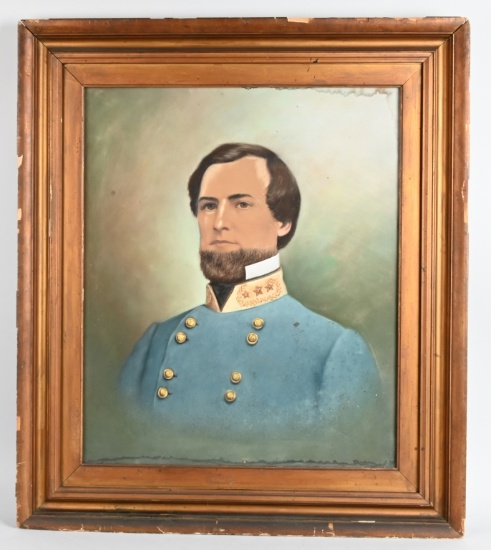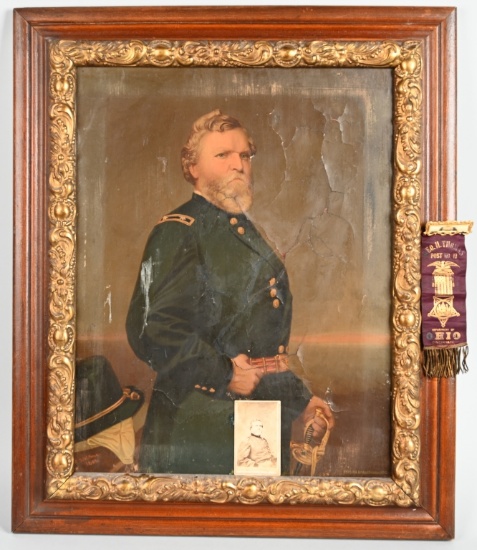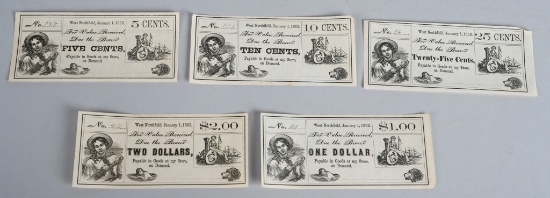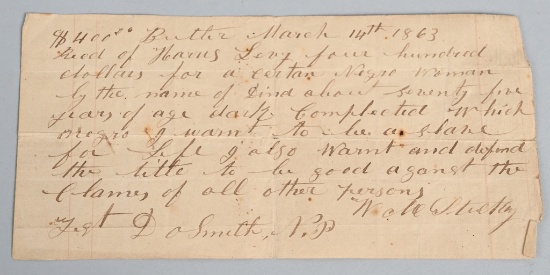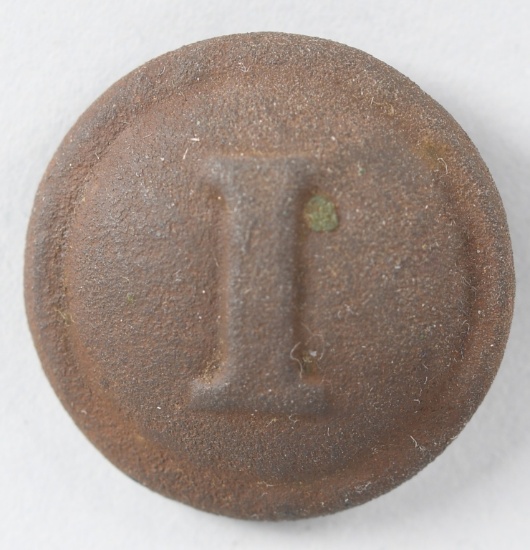
HISTORIC MILITARIA, WEAPONS, & FIREARMS DAY 1

HISTORIC MILITARIA, WEAPONS, & FIREARMS DAY 1
See Special Terms for additional fees
Cash Payment Discount: 3%
Description
PROUDLY PRESENTS
HISTORIC MILITARIA, WEAPONS, & FIREARMS DAY 1
Historically Important Militaria items to include a rare Civil War General's Garrison 35 Star Silk Flag, Gold Army of the Cumberland Corps Badge, Civil War ID'ed Badges, D-day Flag Flown on Omaha Beach LCI-413, British D-day used "Rupert" Paradummy, Wehrmacht General's Tunic as well as many others Nazi Luftwaffe General and Heer General's Visor Hats as well as several Waffen SS officer's and EM/NCO caps, Several numbered Panzer Assault Badges, Honor Clasp's of the Heer and Kriegsmarine, Waffen SS Cufftitles, German Dagger's of several types, US Bomb Sights including several Norden's and ultra rare A-26 Bomber Periscope Sight, plus a great selection of US uniforms including several Airborne Groupings, plus many more rare and historical items from Civil War - Vietnam Conflict.
Large selection of Rifles, Shotguns, Pistols and Revolvers. Highlights include: Boxed Colt Python, Cased Browning 3 Pistol set, Cased Gyrojet Rocket pistol, High Grade 1911... Show more Show Less
Cash Payment Discount: 3%
Participation Requirements: Valid Credit Card required for bidding approval
Payment Options: Visa, MasterCard, Discover, American Express, Check, Money Order, and Wire Transfer
Visa MasterCard Discover American Express
Payment Instructions: SALES TAX All buyers will pay applicable state sales tax. Sales Tax will be charged unless the item is being shipped out of state or the buyer provides a current state exemption form. PAYMENT All merchandise must be paid in full within ten (10) days of the date of the sale. Purchases totaling $20,000 or more must be paid within three (3) days of the date of the sale. Call 440-527-8060 to pay your invoice by phone or mail payment to: 38198 Willoughby PArkway, Willoughby Ohio, 44094. Absentee bids placed through www.milestoneauctions.com and Proxibid.com will be auto charged to the credit card entered 48 hours after the end of the sale. If you wish to pay by another method please contact us within 48 hours after the sale. BUYER'S PREMIUM A 20% buyer's premium will be added to all successful bids and is payable by the purchaser as part of the total purchase cost. +3% applied for all credit card payments. Split payments are subject to a 23% buyer's premium if a credit card is used as any form of total payment. PAYMENT All merchandise must be paid in full within ten (10) days of the date of the sale. Purchases totaling $20,000 or more must be paid within three (3) days of the date of the sale. Call 440-527-8060 to pay your invoice by phone or mail payment to: 38198 Willoughby Parkway, Willoughby, Ohio, 44094.Absentee bids placed through our website will be auto charged to the credit card entered 48 hours after the end of the sale. If you wish to pay by another method please contact us within 48 hours after the sale. We accept Visa, MasterCard, Discover, American Express, personal checks/ certified checks, wire transfer, money orders, and cash. -CREDIT CARD - For first time buyers and credit card charges greater than $2,500.00 buyers must complete the bottom portion of the invoice and must specifically sign the acknowledgement of our terms of sale before we will accept payment via credit card. We do offer the convenience of paying automatically by credit card. If you wish have your card automatically charged for all purchases please complete our 'Authorization for Automatic Credit Card Use.' We have this form available upon request. Split payments are subject to a 23% buyer's premium if a credit card is used as any form of total payment.-CHECK - There will be a $30.00 service charge for returned checks. Make checks payable to: Milestone Auctions LLC. Milestone Auctions reserves the right to hold items paid for by personal or company check until said check clears (14 days). Milestone Auctions has the right to hold all checks over $2,000.00. Customers who have an established successful buying history with Milestone Auctions may be exempt from this. We will accept a personal or company check >$2,000 and/or from a first time buyer if you provide a Bank Letter of Credit, available on our website.In the few situations where a successful bidder does not remit payment when due, Milestone Auctions will proceed with the legal steps necessary to protect its interests and will block the bidder from future auction participation. In the few situations where a successful bidder does not remit payment when due, Milestone Auctions will proceed with the legal steps necessary to protect its interests and will block the bidder from future auction participation.
Currency Type: USD
Shipping Instructions: Please see our terms and conditions.
Preview Date & Times: Items are available for preview 7 days prior to the sale by appointment. Auction day preview is January 24th at 8AM.
Checkout Date & Times: Please contact the auction company for checkout dates & times.
Location: 38198 Willoughby Parkway, Willoughby, OH 44094
Driving Directions:

By clicking "Confirm Buy" you are agreeing to the terms of the sale. Instant Purchase items may have additional fees such as an Internet Premium, Sales Tax, Shipping or other fees not included in the Instant Purchase price. Please see Auction Information for full details.
Payment Type:
ULTRA RARE CIVIL WAR SILK 35 STAR FLAG OR GUIDON
Lot # 1 (Sale Order: 1 of 733)
CIVIL WAR ARMY OF THE CUMBERLAND GOLD CORPS BADGE
Lot # 2 (Sale Order: 2 of 733)
CIVIL WAR MEDAL OF HONOR WINNER NAMED ALBUMEN
Lot # 3 (Sale Order: 3 of 733)
MODEL 1841 MISSISSIPPI SNELL CONVERSION BAYONET
Lot # 4 (Sale Order: 4 of 733)
CIVIL WAR ID'ED 96TH OHIO AMBROTYPE & UNIT HISTORY
Lot # 5 (Sale Order: 5 of 733)
CIVIL WAR MOLLUS MEDAL GROUPING 31ST OVI
Lot # 6 (Sale Order: 6 of 733)
CIVIL WAR SILVER HILTED PRESENTATION SWORD
Lot # 7 (Sale Order: 7 of 733)
CIVIL WAR ID'ed IRON BRIGADE GOLD REUNION BADGE
Lot # 8 (Sale Order: 8 of 733)
CIVIL WAR ERA MILITIA KNIGHTS HEAD POMMEL SWORD
Lot # 9 (Sale Order: 9 of 733)
RARE PRE CIVIL WAR AMES KNIGHTS HEAD MILITIA SWORD
Lot # 10 (Sale Order: 10 of 733)
PRESENTATION M1902 NAMED OFFICER'S SWORD
Lot # 11 (Sale Order: 11 of 733)
CIVIL WAR CONFEDERATE GENERAL L O BRANCH PAINTING
Lot # 11a (Sale Order: 12 of 733)
CIVIL WAR CONFEDERATE WOOD DRUM CANTEEN w/ STRAP
Lot # 12 (Sale Order: 13 of 733)
CIVIL WAR KETCHUM GRENADE w ORIGINAL FINS INERT
Lot # 13 (Sale Order: 14 of 733)
CIVIL WAR OFFICER'S SPURS SCHUYLER HARLEY GRAHAM
Lot # 14 (Sale Order: 15 of 733)
CIVIL WAR M1850 FOOT OFFICER'S SWORD BY AMES MINT
Lot # 15 (Sale Order: 16 of 733)
MEXICAN WAR AMES M1840 WRIST BREAKER 1849 DATED
Lot # 16 (Sale Order: 17 of 733)
MEXICAN WAR OFFICER GROUP DAGUERROTYPE COMMISSIONS
Lot # 17 (Sale Order: 18 of 733)
19th CENTURY GATLING GUN 45/70 STICK MAGAZINE
Lot # 18 (Sale Order: 19 of 733)
CIVIL WAR 1ST US ARTILLERY ID'ed CANTEEN GOBLET
Lot # 19 (Sale Order: 20 of 733)
3 pc GENERAL THOMAS EHRGOTT & KREBS LITHO, CDV GAR
Lot # 19a (Sale Order: 21 of 733)
5 pc. 1862 STORE SCRIP PAYMENT WEST NORTHFIELD MA
Lot # 19b (Sale Order: 22 of 733)
CIVIL WAR LOT OF 24 PATRIOTIC COVERS ENVELOPES
Lot # 20 (Sale Order: 23 of 733)
CIVIL WAR DATED SLAVE TITLE
Lot # 20a (Sale Order: 24 of 733)
CONFEDERATE INFANTRY BUTTON RICHMOND VA. RMDC
Lot # 20b (Sale Order: 25 of 733)
| Bid Range | Increment |
| $0.00 - $299.99 | $10.00 |
| $300.00 - $999.99 | $25.00 |
| $1,000.00 - $1,999.99 | $50.00 |
| $2,000.00 - $4,999.99 | $100.00 |
| $5,000.00 - $9,999.99 | $250.00 |
| $10,000.00 - $24,999.99 | $500.00 |
| $25,000.00 - $49,999.99 | $1,000.00 |
| $50,000.00 - $99,999.99 | $2,500.00 |
| $100,000.00+ | $5,000.00 |

 x Cancel
x Cancel










